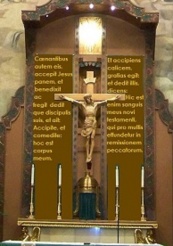Which translation of the Bible is the correct one? St Augustine writes in “On Christian Doctrine, “In the case of direct signs ambiguity may arise from the punctuation, the pronunciation, or the doubtful signification of the words, and is to be resolved by attention to the context, a comparison of translations, or a reference to the original tongue.”
 Which is the correct translation when the solution is a comparison of several translations? Book II Chapter 12 of this text is a full chapter on how we find part of the solution by reading multiple translations. Jewish understanding of “Bible,” has two parts, “הַגָּדָה, אַגָּדָה; “narrative”, and halakhah, “Jewish walk.” The majority of our Bible is narrative. Torah has the Hebrew root of showing. Narrative, a showing, is the key point of the story. Precision of words is not helpful here. In understanding the idea of walk, precision of words becomes important. St. Augustine points to context and a reference to the original languages.
Which is the correct translation when the solution is a comparison of several translations? Book II Chapter 12 of this text is a full chapter on how we find part of the solution by reading multiple translations. Jewish understanding of “Bible,” has two parts, “הַגָּדָה, אַגָּדָה; “narrative”, and halakhah, “Jewish walk.” The majority of our Bible is narrative. Torah has the Hebrew root of showing. Narrative, a showing, is the key point of the story. Precision of words is not helpful here. In understanding the idea of walk, precision of words becomes important. St. Augustine points to context and a reference to the original languages.
In Vatican II states, “God speaks in Sacred Scripture through men in human fashion, the interpreter of Sacred Scripture, in order to see clearly what God wanted to communicate to us, should carefully investigate what meaning the sacred writers intended… To search out the intention of the sacred writers, give attention to “literary forms.”
 Learning sacred languages will point to the puns and literary forms. The Beatitudes of Matthew 5 use the literary form, “Chiasmus.” The middle terms are important. The middle terms of the Beatitudes are of justice and mercy, which in Hebrew are related concepts. The ideal society is one in which all remember, first hand, what it was like to be slaves. They develop compassion for the less fortunate; this is mercy. When they act on compassion, this is justice. Imagine a society where all so busy helping one another, nobody had time to harm his neighbor.
Learning sacred languages will point to the puns and literary forms. The Beatitudes of Matthew 5 use the literary form, “Chiasmus.” The middle terms are important. The middle terms of the Beatitudes are of justice and mercy, which in Hebrew are related concepts. The ideal society is one in which all remember, first hand, what it was like to be slaves. They develop compassion for the less fortunate; this is mercy. When they act on compassion, this is justice. Imagine a society where all so busy helping one another, nobody had time to harm his neighbor.
A kal vahomer argument is often, but not always, signaled by a phrase like “how much more…,” one of Jesus’ favorite phrases. Jesus uses Hebrew rhetoric. G’zerah Shavah (Equivalence of expresions,) an analogy is made between separate texts using a similar phrase, or word. We see this in John the Baptist and Jesus. “Do not presume to say, ‘We have Abraham as our father.’ I tell you, God can raise up children to Abraham from these stones.” A chapter later, “The tempter approached and told him, “If you are the Son of God, command that these stones become bread.” The lesson is about leadership. Stones refers to people, not stones.
Torah has much more of this rhetoric, too many to present here. Learning these will give a more detailed picture of what the original writer tries to tell us than insisting on one translation. When Augustine speaks of signs, he speaks of words, and chapters drawing a picture. A valid translation must draw an accurate picture, which means drawing a picture, something neither King James nor Douay-Rheims do. For this, we need modern translations, plural.
